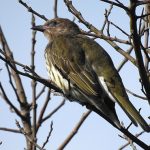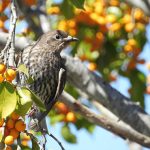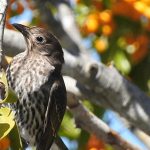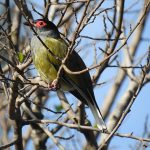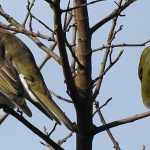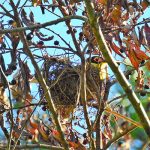AUSTRALASAN FIGBIRD
Australian Figbird is one of Australia’s more sociable songbirds.
Quick Facts
| Scientific Name | Sphecotheres vieilloti |
|---|---|
| Common Name | Australian Figbird |
| Family | Oriolidae (the oriole family) |
| Size | 27–29 cm (about the size of a ruler) |
| Status | Least Concern (IUCN Red List) |
| Distribution | Eastern & Northern Australia, incl. New Guinea |
| Habitat | Woodlands, urban parks, gardens, mangroves |
Identification: Who’s That Bird?
- Male: Males are the show-offs with olive-green bodies, a blackish head, and a striking red facial skin (think: a bit of a fruit salad with attitude). Their beak is pale, and those beady eyes really pop against their red mask!
- Female: Females keep it classic and subtle — dull olive and grey above, streaked white and brown below, and no bright red facial skin.
Fun Fact: The facial skin of the male can vary in intensity depending on mood and season.
Behaviour: Social Life & Song
- Social Creatures: Figbirds love a crowd! They’re highly gregarious, often spotted in noisy flocks, especially near fruiting trees.
- Diet: As the name suggests, figs are a favourite, but they’ll tuck into various other fruits, berries, nectar, and even the odd insect.
- Call: Their vocalisations are typically a mix of chattering and whistling — not quite opera, but certainly distinctive.
Distribution & Habitat
You’ll find Australian Figbirds along the coastal and sub-coastal zones from the Kimberley in Western Australia, across the Top End, and down the east coast to about Sydney. Their adaptability means they’re just as happy in city parks and gardens as in mangrove forests and woodlands.
Breeding & Nests
- Nesting Season: Mostly from September to March, timed beautifully with the abundance of food.
- Nest: A rather scruffy open cup woven from twigs — not winning any bird architecture awards, but it does the trick!
- Eggs: 2–4 pale blue-green eggs, nestled snugly in the messy nest, are incubated mostly by the female.
Conservation & Interesting Tidbits
- Status: Their population is stable, benefiting from urban planting of fruiting trees.
- Ecosystem Role: By loving fruit, they’re unintentional seed spreaders, helping maintain healthy ecosystems.
- Namesake: The species name
vieillotihonours the French ornithologist Louis Jean Pierre Vieillot—an apt tribute for a bird that flocks together in style!
Why Care About Figbirds?
- They’re a visible, vocal reminder of nature in your backyard.
- Excellent study subjects for research on urban adaptation and wildlife ecology.
- A living lesson on how wildlife can flourish in both wild and urban settings.
Photo Gallery
So, this short ‘Close Encounters’ video is of the Figbirds I have seen in Northern New South Wales, Australia. The males aren’t as colourful as their northern relatives in Queensland, but they are just as noisy. Have a look and compare the 2 sub-species of Figbirds that we have in Australia.
Since moving to the wet tropics in Northern Queensland, Australia, Sharon has seen and filmed many of the Qld Figbirds, subspecies flaviventris . They are different in colouration to their southern relelatives in Northern NSW. The males being a lot brighter. These are a common bird of the tropics and we are awoken each morning with their joyful and sometimes raucous songs.

